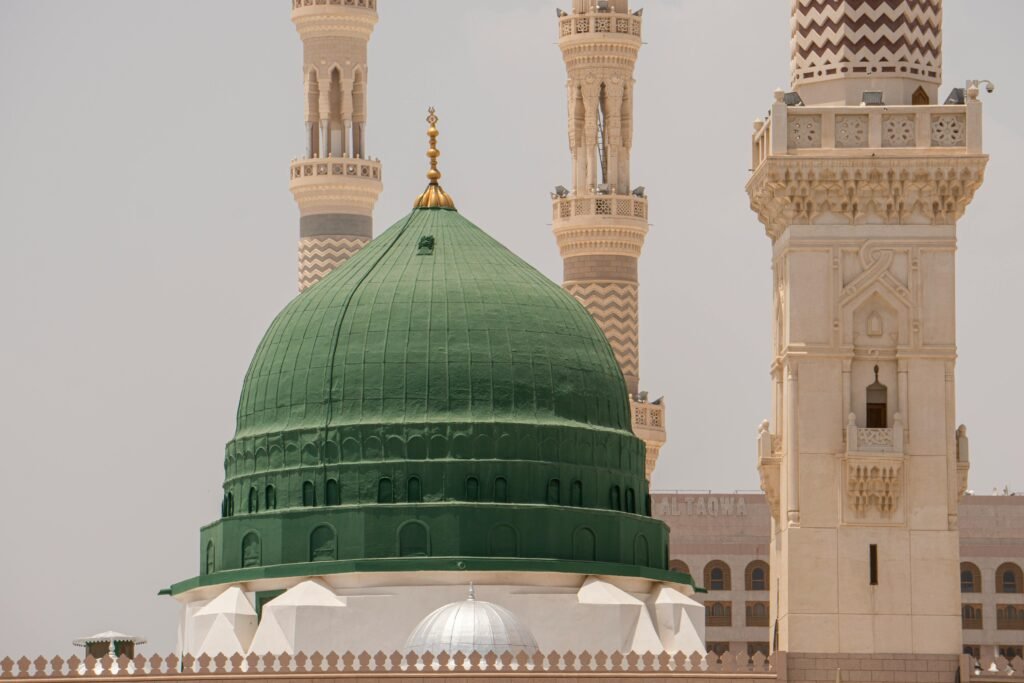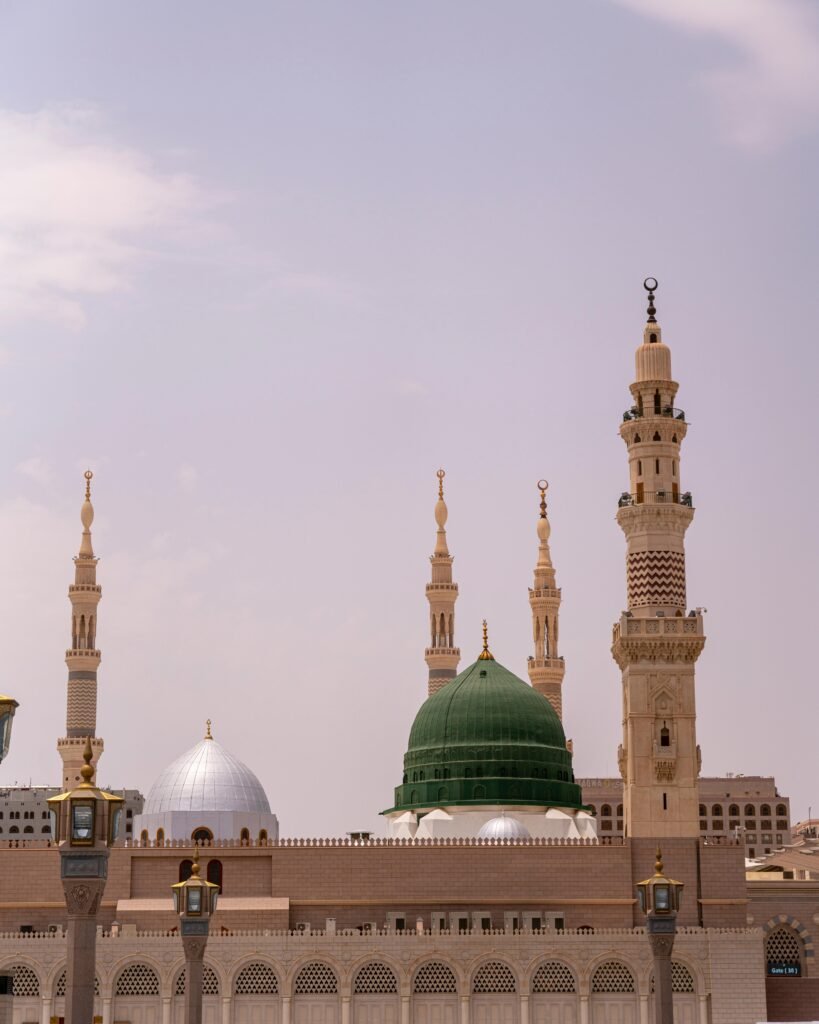The first inhabitants of Medina
It is narrated that after the great flood during the time of Prophet Noah (PBUH), the first people to settle in Medina were his descendants, specifically Qaynah bin Mahlabeel bin Obail. However, those who settled in Medina permanently, cultivated the land, and planted trees were the Amalik tribe. They were the descendants of Banu Amlak bin Arkhassaf bin Saner. Among them, Banu Haf and Banu Matarail are particularly notable.
This account is mentioned by Razin ibn al-Munzir al-Sharqi. He cites Suleiman bin Ubaidullah bin Hanzalah and another Qurayshi’s narration, stating: When Prophet Musa (PBUH) came for Hajj, some members of Bani Israel also accompanied him. On their way back from Makkah, they arrived at Medina. There, they observed the city’s characteristics and qualities as mentioned in the Torah, which described the future Prophet. A portion of them stayed in Medina, and they settled in the area of the Banu Qaynuqa market. Following their example, others also began settling in Medina. However, it is primarily the Amalik tribe who are considered the first permanent settlers in the city. This view is regarded as the most reliable.
According to a narration from Abu Huraira (RA), after the Israelites faced persecution under King Balthasar of Babylon, they dispersed to various regions. They had heard of a prophecy in the Gospel about the emergence of a prophet named Muhammad (PBUH) in an Arabian land with date-palm gardens. Consequently, they searched for this city from Syria to Yemen and finally found it in Yathrib (Medina). A part of Prophet Harun’s (PBUH) lineage settled in Medina with the Torah, encouraging their descendants to believe in the future Prophet Muhammad (PBUH). All the Jews eagerly awaited the arrival of the last prophet, but upon his arrival, many rejected him, broke their promises and agreements, and conspired against him in an attempt to destroy Islam. However, they could have lived peacefully with the Muslims if they had not broken their agreements, but fearing the loss of their power, they opposed Islam and the Prophet Muhammad (PBUH).
Meanwhile, the Ansar (helpers) were members of the Aws and Khazraj tribes. In the late 2nd century BCE, due to a flood in Yemen, the Ma’rib Dam was breached, and various tribes scattered throughout the Arabian Peninsula. The Aws and Khazraj tribes arrived in Medina and settled there. At that time, the Jews were in control of Medina. As a result, the Aws and Khazraj tribes entered into an alliance with them. Over time, their wealth and properties increased, and the Jews grew envious. Eventually, the Jews plotted to expel the Aws and Khazraj tribes from Medina. The Jews controlled Medina’s economic, political, and military power and subjected the tribes to harsh oppression.
Yaqut al-Hamawi mentioned in his Mu’jam al-Buldan that during the Jewish rule in Medina, no woman from the Aws and Khazraj tribes was allowed to live with her husband until she had spent the night with the Jewish King Fathion and lost her virginity. This degrading and disgraceful practice became intolerable. Malik bin Ajlan Khazraji, a courageous and self-respecting man, refused to allow his sister to be subjected to such humiliation. Disguised as a woman in female clothing, he entered the king’s court, hiding a sword beneath his robe. Once inside the harem, he killed the king with the sword. Fearing revenge from the Jews, the Aws and Khazraj tribes sought assistance from their relatives in Syria and from the last Tuba ruler of Yemen, Karb bin Hassan bin As’ad al-Humayri. Together, they defeated the Jews and gained control of Medina. Similar oppression in Yamama led to the defeat of the Jews there as well.
The Aws and Khazraj tribes were in a prolonged conflict for 120 years, often over trivial matters such as watering camels. This prolonged war ended after they embraced Islam.
The exact date of the founding of Medina is not definitively known. It is believed to have been established around the 10th century BCE or even earlier. Several factors likely contributed to its establishment, including its fertile land, its strategic position along the trade route between Syria and Yemen, and the migration of a portion of the ancient Arabian tribes to settle there. The first settlements were made around the Uhud Mountain, the Kana Valley, Quba, Qurban, and Zorfa.
Description of Medina
Geographical Description: Medina is an oasis in the Hejaz region, located at 39.36 degrees east longitude and 24-28 degrees north latitude. The city is naturally divided into two parts: Alia and Safilah. The southeastern part is known as Alia (highland), situated 620-640 meters above sea level. It is densely populated, with areas like Quba and Qurban located within this elevated region. The rest of the city is known as Safilah (lowland), located 610–620 meters above sea level. Medina covers an area of about 50 square kilometers.
Medina is surrounded by mountains on all sides, with the northern and southern mountains being closer to the city than the eastern and western ones. The water in all of Medina’s valleys flows northwest, as this area is the city’s lowland.
Current Population
Around 25% of Medina’s total population resides within the 1 square kilometer area surrounding the Prophet’s Mosque. In the eastern region, 16% live there, while 47% reside in the western area and Quba. The Sayyid al-Shuhada area has 11% of the population, and Sultaniah houses 1%. The city experiences a large influx of people during the Hajj and Umrah seasons, with many visitors flocking to the Prophet’s Mosque. According to statistics from 1974 (1394 AH), the population of Medina city was approximately 200,000, while the overall population of the Medina region was 519,000. This accounts for 7.41% of Saudi Arabia’s total population. Today, Medina’s city population is around 500,000. The people of Medina are known for their humility and helpfulness, always willing to lend a hand when needed. Medina could rightfully be called the city of cooperation.
Weather in Medina
The weather in Medina is generally divided into three seasons:
- Summer—Extremely hot, with strong winds.
- Spring and Autumn—mild and pleasant weather.
- Winter—Very cold, and on occasion, windows need to be closed and heaters turned on for comfort.
The recorded temperatures for each month can give a complete picture of the city’s weather:
| Month | Max Temp (°C) | Min Temp (°C) |
| January | 29 | 7 |
| February | 32 | 11-5 |
| March | 35.5 | 13.5 |
| April | 41 | 17-2 |
| May | 46 | 21-5 |
| June | 45.2 | 24 |
| July | 88 | 23 |
| August | 46 | N/A |
| September | 43 | 25 |
| October | 80 | 18 |
| November | 34 | 13 |
| December | 27-4 | 5.5 |
Boundaries of Medina
Medina is bordered by several mountains:
- To the northwest, it is bounded by the Sala’ mountain.
- To the south, the area of Ayr mountain (near Zul-Hulayfah) and the Aqeeq valley.
- To the north, the Uhud and Sawr mountains and the Kana valley.
- To the east and west, the Harrah ash-Sharqiya and Harrah al-Gharbiya mountains (eastern and western lowland mountainous areas). The Bat’ha valley runs through the middle of the city, merging with the Quba Ranuna valley.
Harams of Medina
The boundaries of Medina’s Haram (sanctuary) are described in the Hadith narrated by Hazrat Ali (RA) in Sahih Bukhari and Sahih Muslim. The first part of the Hadith states, “Medina is sacred between the mountain of Ghayr and the mountain of Thawr.”
In Medina, unlike Makkah, no markers or pillars were set up for the boundaries of the Haram. The boundaries are marked by the Sawr mountain to the north, the Ayr mountain to the south, and the eastern and western Harrah (mountainous regions). The distance between Sawr and Ayr mountains is about 16 kilometers. Currently, Medina City spans 1300 hectares of land.
The Haram area of Medina’s northern boundary (Sawr mountain) is located about 8 kilometers from the Prophet’s Mosque, and the southern boundary (Ayr mountain) is also 8 kilometers away. These two mountains lie outside the Haram boundary, while the two Harrah areas, eastern and western, are included within the Haram.
Medina’s Haram is of two types. One is the hunting-prohibited Haram area, and the other is the tree-cutting-prohibited Haram area.
The tree-cutting was prohibited. Haram is also called حضى المدينة or “Medina’s pastureland.” This pastureland is a circular area surrounding Medina, with Medina located at the center of that circle. However, it is not necessary for the Prophet’s Mosque to be located at the center of that circle. For in the Hadith, there is no special mention regarding this matter. In any case, the circumference of that circle is 12 miles, meaning that its distance is almost equal in every direction. Within this Haram boundary, tree cutting is prohibited; however, it is not prohibited to let camels and livestock graze.
The second Haram is the hunting-prohibited Haram area. This Haram boundary is essentially the desired Haram. The term “Medina’s Haram area” refers to this. All the virtues described concerning Medina’s Haram are applicable only to this Haram.
It has been encouraged to reside and to die in this Haram, and a warning has been pronounced against displaying fear in this area, along with the Prophet’s (PBUH) supplication for double the blessing in Medina’s measuring instrument compared to that of Makkah.
In the Hadith, the space between the two “Labah” is designated as the boundary of this Haram. Labah means an area characterized by black stone as a result of a volcanic eruption. Perhaps at some point in history a volcanic eruption occurred here that led to it being designated by this name. The aforementioned Labah is currently called “Harrah.” In the east there is Harrah Wakim, and in the west there is Harrah Wabarah. In the south there is the mountain of Ayr or Ayer, and in the north there is the mountain of Sawr. The word “sawr” means bull. It is a humped mountain that is located to the north of Medina and to the west and behind the Uhud mountain. The color of the mountain is a mixture of red and black. On the mountain there are three high humps resembling the hump of a camel. When viewed from the northwest, the mountain resembles a bull. The mountain is located immediately after Al-Khula’il Road and to the right after the Suyarez Line. When one ascends this mountain, the mountain of Ayr is seen directly to the south.
Designating Sawr Mountain as the northern boundary is nothing more than a tactic to enclose the entire Uhud Mountain within the Haram boundary. The mountains of Ayr and Sawr are not included within the Haram boundary.
On the other hand, the western Harrah, or Harrah Wabarah, is entirely included within the Haram boundary, and a portion of the eastern Harrah, or Harrah Wakim, is included within the Haram boundary. In this regard, a Hadith narrated by Hazrat Abu Huraira in Sahih Bukhari states that the Prophet (PBUH) went to the Bani Haresa tribe and said, “I suppose you are outside the Haram boundary.” Then he looked carefully and said, “Rather, you are within the Haram boundary.” At that time, because the Bani Haresa tribe resided in a place called Al-Orayd, they were included within the Haram boundary.
The Aqiq Valley is located in the western Harrah and is included within the Haram boundary. For in the Hadith narrated by Hazrat Saad bin Abi Wakkas in the Muslim Sharif, it is mentioned that he confiscated everything belonging to a slave who was cutting trees. When the slave’s agent came to Hazrat Saad demanding the return of the confiscated property, he replied, “How can I return that which the Prophet (PBUH) has made lawful for me as war booty?” This indicates that the Aqiq Valley is also included within the Haram boundary.
Fundamentally, the area of the tree-cutting-prohibited Haram and the hunting-prohibited Haram is the same and uniform. In the earlier Hadith, the southern and northern boundaries have been precisely defined by the mountains of Ayr and Sawr. However, in the east and west, it has not been defined clearly; rather, only two areas have been mentioned. Nonetheless, according to the aforementioned Hadith, the parts of that area that are included within the Haram boundary have been specified. Accordingly, if it is possible to designate the same distance in the east and west as the distance between the mountains of Ayr and Sawr, that is preferable. As a result, the precise area of the Haram can be determined. A photograph taken from above the city shows that the distance between the mountains of Ayr and Sawr is 15 kilometers. Therefore, an equivalent distance in the east-west direction is assumed as the desired boundary. 10
From Medina to the southern shore of the Red Sea at Yanggu, the distance to the seaport is approximately 275 kilometers, the distance to Jeddah is 425 kilometers, the distance to Makkah is 497 kilometers, the distance to Damascus is 1303 kilometers, and the distance to the Jordan border is 844 kilometers. Medina is well connected by broad paved roads with all the cities of Saudi Arabia and neighboring countries. Furthermore, due to the presence of an airport, there is also efficient air connectivity.



